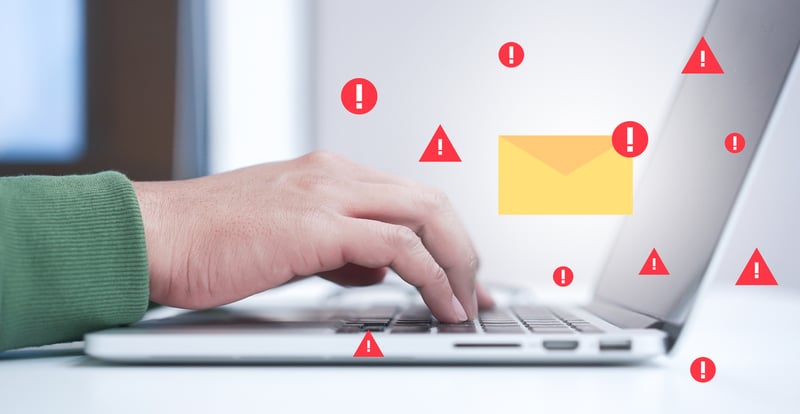Anti-Phishing Protection Strategies
Phishing attacks pose a significant threat to organizations, with as much as 94% of all malware delivery occurring through such attacks.
While it is difficult to eliminate phishing attempts, organizations can use three key strategies to reduce their exposure to such attacks significantly:
1. Email Filtering
An effective strategy for reducing the number of threats each employee faces through email is email filtering. It involves using certain filters that can be implemented through various options, from on-premise systems to SaaS services.
Third-party email filtering vendors offer the advantage of having a broader view of spam patterns, which businesses can use to learn from and apply solutions to prevent certain types of attacks from happening in the future. Some email filters even offer AI-supported filters and are able to manage accounts for signs that they've been compromised actively.
2. Email Server Settings
Organizations can also limit email attacks by implementing DomainKeys Identified Mail (DKIM), Sender Policy Framework (SPF), and Domain-based Message Authentication, Reporting, and Conformance (DMARC) protocols.
- SPF limits who can use a domain to send emails and hardens DNS servers.
- DKIM adds information to email headers to certify email verification and domain ownership.
- DMARC builds upon the previous two protocols by providing email authentication and verifying the other two are in place.
3. Employee Education
Another crucial strategy for anti-phishing is educating employees about cyber security basics, including the types of phishing attacks that are on the rise and how to avoid becoming a victim.
For example, employees should be aware of the risks of clicking "unsubscribe" options in spam emails, opening G-Suite or Microsoft Office files from unknown sources, or enabling macros containing malicious code. Cybersecurity education programs, such as anti-phishing education, can be used to spread current information and assist with reducing cybersecurity incidents.
Anti Phishing Best Practices

Phishing attacks can devastate businesses, but several preventative measures and best practices can be implemented to minimize the risks:
Stay Updated with the Latest Phishing Techniques
Cybercriminals constantly update their phishing techniques. It's important to stay informed and educated on the latest trends to spot potential attacks. This can be done in various ways, from following trusted cybersecurity news websites from the government or well-known sources like Microsoft, Google, or AWS.
Think Twice Before You Click
Before clicking on any links or entering personal information, take a moment to verify the source's legitimacy. Look for clues like the URL structure and branding to ensure the website is secure and legitimate. Hovering your mouse over an inline link to confirm that the URL matches the website that you'd expect to be taken to is a good habit to form before opening links in an email. Some malicious attackers may use URL shorteners to disguise links further. Common sense often prevails here. If a URL shortener is used for no reason, like in an email message with an inline link where the URL length doesn't matter, it's best not to click on the link.
Verify a Website's Security
Ensure a website is encrypted with an SSL certificate, indicated by HTTPS at the beginning of the URL, and a lock symbol, which is usually in the address bar before the URL. Lack of encryption is a clear red flag and should be avoided.
Keep Your Web Browser Up to Date
Regularly update your web browser to ensure security is not compromised. Cybercriminals often exploit vulnerabilities in outdated software.
Use a Firewall
A firewall adds an additional security layer and acts as a buffer between the user and the intruder. A personal or network firewall can help filter traffic and minimize risk.
Educate Employees About Current Phishing Threats
Provide education and training to employees to help them recognize and defend against phishing attacks. They can serve as the first and last defense against such scams. Employees should be taught the basics of how to recognize a phishing attempt in email and other programs, such as instant messengers (e.g., Slack, Yammer) that your organization uses.
Develop Corporate Email Policies
Establish email policies to safeguard the company against phishing attacks. A corporate email policy could include the following points:
- Signing up for disreputable websites or services using a company email
- Sending unauthorized marketing or solicitation emails from a company email
- Intentionally spamming other employee's or client's emails
- Not writing down your password in a visible location (e.g., on a Post-it note to attach to a computer screen)
- Use a strong password (3 random words, special characters, etc.)
Encourage Password Security Best Practices
Creating strong and unique passwords, enabling Multi-Factor Authentication, and using SMS tokens to verify identity can make it harder for cybercriminals to access accounts.
Office 365 Anti Phishing

Microsoft has implemented a variety of anti-phishing capabilities to protect its users from email-based attacks. These features identify and block malicious emails before they reach the user's inbox.
Anti-phishing Features in Office 365
Following are the key anti-phishing capabilities offered by Office 365:
Exchange Online Protection
Exchange Online Protection (EOP) is a cloud-based email filtering service that protects organizations against email threats such as spam, malware, and phishing. EOP is included in all Microsoft 365 offerings with Exchange Online mailboxes and can also be used to protect on-premises mailboxes and mailboxes that exist in hybrid environments.
When an email enters EOP, it goes through several filtering processes to check the sender's reputation, detect malware, evaluate against mail flow rules, and identify harmful messages. If the email successfully passes all protection layers, it's delivered to the recipients.
EOP runs on a worldwide network of data centers to provide the best availability, with load balancing between data centers. The service uses several URL block lists, a vast list of domains known to send spam, and multiple anti-malware engines to protect customers at all times. EOP also inspects the active payload in an email message body, as well as all attachments for malware.
Microsoft Defender for Office 365
Microsoft Defender for Office 365 is a cloud-based email filtering service that protects organizations from threats such as phishing, business email compromise, and malware attacks. The service provides investigation, hunting, and remediation capabilities that help security teams identify, prioritize, investigate, and respond to threats.
Defender for Office 365 can be used in various ways, such as:
- Providing cloud-based email protection for on-premises Exchange Server environments
- Protecting Exchange Online cloud-hosted mailboxes
- Configuring to protect messaging environments with a mix of on-premises and cloud mailboxes with Exchange Online Protection for inbound email filtering.
There are two plans available: Plan 1 and Plan 2. The plans offer different features, such as Safe Attachments, Safe Links, Anti-phishing policies, and Real-time reports. Plan 2 offers more advanced features, such as Automated investigation & response, Attack simulation training, and Integration with Microsoft 365 Defender.
Anti-phishing Features in Outlook
In Outlook, Microsoft provides several anti-phishing features, such as:
Safety Tips
Outlook includes safety tips that alert users to potentially suspicious emails. Safety tips can warn users when an email is coming from an external sender when an email includes a suspicious link or attachment, or when the email content seems inconsistent with the sender's identity. These safety tips help users identify potentially harmful emails and take appropriate action.
Junk Email Filtering
Outlook's junk email filter automatically filters emails it identifies as spam or junk, reducing the risk of users being targeted by phishing emails. This feature also moves such emails to the junk email folder, making it easier for users to identify potentially harmful emails and delete them without opening them.
External Email Warnings
Outlook can display warnings for emails that come from external senders. These warnings can alert users to potentially malicious emails and make it easier to identify suspicious emails. External email warnings also encourage users to exercise caution when opening emails from external senders and verify the sender's identity before responding.
Anti-phishing Features in Exchange
In Exchange, Microsoft provides the following anti phishing features, such as:
Anti-spam Protection
Exchange provides built-in anti-spam protection that filters out known spam and phishing emails, reducing the risk of users being targeted by phishing emails. It uses various techniques to filter spam, such as content filtering, connection filtering, and IP blocklists.
ATP Anti Phishing Policies
Exchange Online Protection (EOP) includes anti-phishing policies that help identify and block phishing emails. These policies use machine learning and advanced heuristics to detect and block suspicious emails before they reach users' inboxes.
DKIM and DMARC
Exchange supports DomainKeys Identified Mail (DKIM) and Domain-based Message Authentication, Reporting, and Conformance (DMARC) protocols, which help prevent email spoofing and improve email security. DKIM allows email senders to attach a digital signature to their emails, verifying the authenticity of the email's sender. DMARC builds on DKIM and helps email receivers determine whether an email is legitimate.
Office 365 Anti Phishing Policy Best Practices
To prevent phishing attacks in Office 365, there are several best practices that organizations can follow, for instance:
Enable Spoof Intelligence
Enabling spoof intelligence is an effective way to protect against spoofed senders through automatic blocking.
Administrators can manually override the spoof intelligence verdict to allow or block the detected spoofed senders from within the insight. If the sender is allowed or blocked, the spoofed sender disappears from the spoof intelligence insight and is now visible only on the Spoofed sender's tab in the Tenant Allow/Block List. Administrators can also manually allow or block entries for spoofed senders in the Tenant Allow/Block List.
Use Unauthenticated Sender Indicators
Unauthenticated sender indicators are components of the Spoof settings accessible under the Security tips and indicators section of anti phishing policies for the two anti phishing software offerings from Microsoft: EOP and Defender for Office 365. When you turn on the spoof settings, the following settings are available:
- Show (?) for unauthenticated senders for spoof: It adds a (?) to the photo of the sender in the “From” box if the message doesn't meet the requirements of SPF or DKIM tests and doesn't pass DMARC and composite authentication.
- Show "via" tag: Adds the via tag (e.g., chris@contoso.com via fabrikam.com) in the “From” box if the domain in the From address differs from the domain in the DKIM signature or the MAIL FROM address.
Activate the First Contact Safety Tip
The "show first contact safety tip" settings are available in EOP and Defender for Office 365 organizations and have no dependency on spoof intelligence or impersonation protection settings.
This safety tip is shown to recipients in the following scenarios:
- The first time they get a message from a sender.
- When they don't often get messages from the sender.
This capability adds an extra layer of security protection against potential impersonation attacks. The first contact safety tip also replaces the need to create mail flow rules that add the header X-MS-Exchange-EnableFirstContactSafetyTip with the value Enable to messages (although this capability is still available if needed).
Anti Phishing Training

Phishing attacks seriously threaten companies, and employees are frequently the weakest point in a business' security chain. Businesses should implement comprehensive anti phishing training.
A comprehensive anti phishing training program for employees should include simulated phishing attacks and continuous monitoring of training effectiveness so the program can be continually enhanced.
- Begin with training for employees: Employee education on the risks of phishing schemes is the first step in an anti-phishing strategy. They can now identify and report emails that are questionable thanks to this information. The training should be delivered via various methods like written documents or online videos, corporate meetings, or classroom training.
- Create fake phishing campaigns: Simulated phishing programs can help employees learn more by giving them scenarios to examine their ability to recognize fraudulent phishing attempts. These programs can come in various forms, including spear phishing, mass phishing, and whaling.
- Review Results and Improvements: The results of anti phishing efforts can help businesses recognize trends and focus their security surveillance on areas most at risk. Analyzing results also helps businesses to improve their anti phishing awareness by informing what additional security measures are needed to safeguard from phishing attacks.
Frequently Asked Questions
What are the Pros and Cons of Free Anti Phishing Software?
|
Pros |
Cons |
|
Free of cost, no need to spend money |
Limited features compared to paid versions |
|
Provides basic protection against phishing scams |
May not offer real-time protection |
|
Can be easily downloaded and installed |
May contain ads or be bundled with unwanted software |
|
Suitable for individuals or small businesses |
May not be suitable for large organizations |
|
Can be a good starting point for anti phishing measures |
May not have dedicated customer support |
How can Amaxra Beacon Help with Anti-Phishing?
Amaxra Beacon is a cutting-edge, complete cyber-security solution created to satisfy the needs of small and medium-sized organizations. By offering sophisticated email security measures that guard against phishing assaults, Amaxra Beacon can aid in the fight against phishing. This includes powerful algorithms for real-time phishing detection, customizable email security policies, employee training programs to teach staff members how to spot and report phishing emails, and incident response services in the event of a phishing assault.
Why Are Phishing Attacks So Successful?
Phishing attacks are successful because they leverage the psychology of humans by using social engineering techniques to trick individuals into divulging sensitive information or taking action, like clicking on a suspicious link or downloading a harmful attachment. They also often rely on the victim's lack of knowledge or awareness of common phishing tactics.
Conclusion
Phishing attacks are a growing threat to businesses of all sizes, but there are several steps organizations can take to protect themselves. Implementing a multi-layered approach that combines employee education, email filters, and technology solutions such as web filters and browser plug-ins can significantly reduce the risk of falling victim to phishing scams.
However, protecting your business against phishing attacks requires ongoing effort and vigilance. It's essential to stay up-to-date on the latest phishing tactics and trends and continually update your anti phishing program to reflect these changes. Additionally, conducting regular security audits and penetration testing can help identify vulnerabilities and areas for improvement.
If you need help protecting your business against phishing attacks, consider partnering with Amaxra, a leading provider of cybersecurity solutions. Amaxra offers a range of services, including employee security awareness training, email filtering, web filtering, and more, to help businesses of all sizes protect themselves from cyber threats.
Contact us today to learn how you can help safeguard your business against phishing attacks and other cybersecurity threats.






